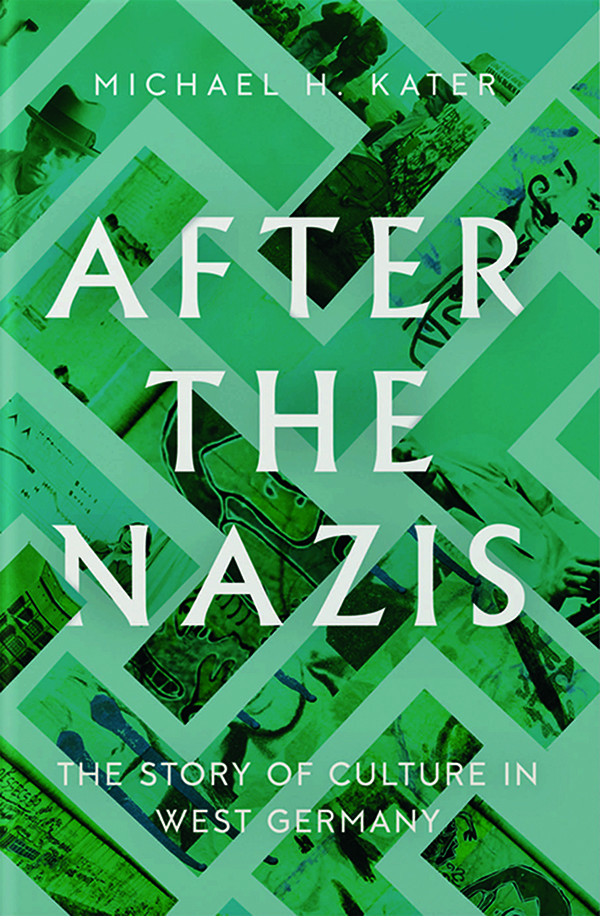
The cultural story of denazification
Anthony Paletta
The qualifications of an author to write about his or her subject are rarely so well established in an opening line as Michael Hans Kater’s are in the first sentence of After the Nazis: The Story of Culture in West Germany: “On Tuesday, May 1, 1945, I was drying a small collection of Hitler stamps on the windowsill of my grandfather’s house in a small village near Bremen in North Germany.” Kater, a distinguished research professor emeritus of history at York University whose work has covered a wide range of German history, here finishes a trilogy of work concerning, respectively, culture in the Weimar Republic, Nazi Germany, and, now, just what the subtitle of this new work says.

In the most consequential ways, West Germany was a state operating after the Nazis. But the Nazis, however you wish to define them, were still all around. Former German Chancellor Helmut Kohl made the most acute observation about “the mercy of late birth” — in his case, 1930 — as the one sure means of dodging complicity in the Nazi state. Kater was younger than that. Short of active dissidents or those persecuted or murdered, Germany was a nation laden with the morally compromised. Obviously, there are considerable differences between those who might have simply kept their heads down or joined the Hitler Youth at 14 and those who operated gas chambers. The problem is that many of the latter were walking around living normal lives after the war.
For those who fell below the level of the Nuremberg trial prosecution, they might face consequences if they had actively engaged in genocide, but often wouldn’t. Waves of amnesties in the 1950s moved many offenders off the list. Governance was mainly successfully sealed off from prominent Third Reich officials, but 52 of 402 delegates of the first Bonn Parliament were former Party members. Even later trials in the 1960s more specifically focused on extermination camps often prominently involved former Nazis as judges and state attorneys. One Jewish journalist, Kater writes, “thought denazification to be a ‘farce,’ which of course it largely was.”
A cultural history revolving around this topic is an intrinsically tricky one, given that any culture consists of hundreds of thousands of people in varying fields. Kater manages this difficult task well, declaring a specific focus upon a relatively finite number of persons but ranging deftly over all sorts of realms. The various artists, authors, and filmmakers at issue “either suffered from Nazism or were, to some degree, complicit — sometimes even both — and so they reacted, with characteristic cultural output.”
Cultural denazification was an early, relatively earnest American and British initiative in their zones of occupation — France did not really try much — and then of the nascent West German state in 1949. It was relatively simple to pick artists to champion in some fields: whoever the Nazis banned. Those in the degenerate art exhibition were back in favor, with Kirchner, Klee, and Grosz on exhibition walls. There were complications here, however. Emil Nolde fell into disfavor purely because he was modern. He was an enthusiastic Nazi and antisemite but embroidered a mythical past of principled dissidence. This largely came to light only in the current century. Emigre authors such as Alfred Döblin, Thomas Mann, and Bertolt Brecht were published again and encouraged, which often did not improve their sales.
Mahler, Mendelssohn, and Hindemith were back on the programs, although those performing their works were often exactly the same conductors, such as Furtwangler and Von Karajan, whose work carried on normally in the Third Reich.
Many fields were far more compromised. “Because many able men had disappeared, any male who was remotely suitable was encouraged to reintegrate into a society that was meant by the Allies to continue. This hugely favored the untainted, but also favored the tainted.”
Journalist Hans Zehrer wrote in 1933 about a “Golden International of Jewry, Money and Trade and called for the removal of Jewish influence from the key institutions of the nation” yet (or should I say “and”?) was the editor of Die Welt in 1946. Die Zeit chief music critic Walter Abendroth had previously written a warning about the “decomposing effects of musical Jewry.” Veit Harlan, director of Jud Süss, possibly the most antisemitic film in human history, returned to directing, making nine more films. To quote a much-memed Mad Men moment: Not great, Bob!
Kater moved to Canada in his teenage years, but he’s not writing about these events from any sort of distance. The book is peppered with his personal experiences of lingering Nazism. He recounts being thrown out of the Bundesarchiv by Nobel Prize-winner Theodor Mommsen’s grandson, irked by his research into the SS. His professor at a postgraduate seminar in Munich, he writes, was an Einsatzgruppen member later credibly accused of murdering Jews in Czernowitz, and may well have killed Paul Celan’s parents.
German culture after the war largely focused on national suffering, which was admittedly real, but the omission of reasons for why this came about bordered on, as Kater puts it, “martyological self-indulgence.” Amid contemporary left-wing demands that American culture dedicate itself to permanent self-laceration for sins past or marginal, it’s revealing to explore a culture that genuinely was ignoring extremely recent and flagrant problems, and far easier to sympathize with this impetus for national reckoning.
German literature, in which many popular Third Reich-era authors continued to sell best, soon featured authors casting a more critical eye on the nation. Wolfgang Koeppen, Heinrich Böll, and Gunter Grass soon took aim at this willful amnesia. Koeppen and Böll’s works frankly featured both wartime atrocities and characters who committed them still at liberty in West Germany. Grass’s work, especially The Tin Drum, addressed the varied madnesses of Nazism acutely. Yet he kept quiet about his own service in an SS unit until 2006. Most literary critics spurned these efforts.
Visual artists kept up this pressure, first in abstraction. As Kater writes, “They believed that through an engagement in abstraction a protest could be lodged against Nazi dictates of the past, which had insisted on representationalism in contemporary art and sculpture to the exclusion of the abstract form.” The 1960s brought more deliberate references to concentration camps, Nazi pasts, and more in the work of Joseph Beuys, Georg Baselitz, Anselm Kiefer, and Gerhard Richter. New German cinema’s greatest talents of Rainer Werner Fassbinder, Werner Herzog, Wim Wenders, and Volker Schlöndorff often took a jaundiced view of the national past.
In the mid-1960s, the pendulum of self-criticism began to swing well and inevitably too far. Nazis were still around, but the increasing far-left contention, advanced not merely with the pen but with bombs and rifles by the Red Army Faction, that West Germany simply was the Nazi state in sheep’s clothing was farcically false. Their formula essentially put the causal cart before the horse, as Kater explains, “by which Nazism was an outgrowth of capitalism and Auschwitz the apotheosis of that logic.” This also usually accompanied the belief that genuinely autocratic East Germany was a near-paradise. Kater, who makes clear his sympathy with the German left throughout, nonetheless has no time for this sort of thinking.
Schadenfreude is the feeling one should feel for some hoisted by their far-left petard. Composer Hans Werner Henze’s debut of an oratorio dedicated to Fidel Castro was disrupted by protesters objecting to it being staged for profit. Henze was reaping what he sowed.
Time may not heal all wounds, but the people who inflicted them will gradually die off, as was the case increasingly by the 1980s in West Germany, when actual Nazis were increasingly rare in public roles. Kater also praises Helmut Kohl as a Christian Democratic leader with a lower tolerance for relics of this unseemly past. There however remained cultural output that attracts his criticism. Edgar Reitz’s Heimat series, for example, allotted an ahistorically peripheral role to Jewish characters.
There are other books on postwar Germany of real quality, yet Kater has managed the most comprehensive on the question of just how Germany became, well, vaguely normal. He accords considerable credit to artists, authors, and filmmakers for providing regular pressure to ensure that this remains the case. They did well. The past is never quite past, but at least it can get more so.
CLICK HERE TO READ MORE FROM THE WASHINGTON EXAMINER
Anthony Paletta is a writer living in Brooklyn.
